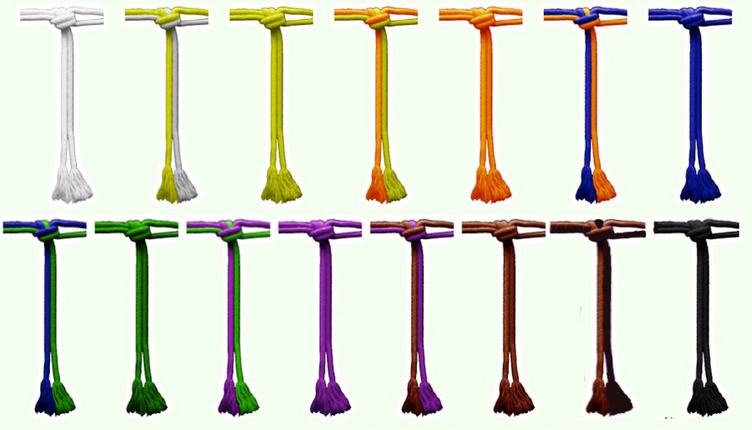Capoeira Luanda Cord System
Eight different colors in their adult 18+ graduation system.
- White (Raw Cord) (Iniciante): Students begin their Capoeira training at this level. The Corda Crua, translated as Raw Cord, signifies that rather than being seen as inexperienced, students are seen as being full of potential for growth.
- Yellow/White (Aluno): Typically this is a cord given to students to welcome them to the world of Capoeira.
- Yellow (Aluno): At this level students begin to demonstrate an understanding of the Capoeira game, and have a basic knowledge of the movements, such as kicks and ground techniques, as well as music. Students know the choruses to many songs and are starting to practice instruments.
- Orange/Yellow (Aluno): Transitional cord.
- Orange (Aluno): At this level students have a much deeper understanding of the Capoeira game. They now begin utilizing many different kicks and acrobatic movements. At this level, students are also capable of singing solos during a roda and playing many different instruments.
- Blue/Orange (Aluno): Students at this level now fully incorporate a large variety of kicks and acrobatic movements, have a large repertoire of songs, and can play any instrument.
- Blue (Graduado): At this level, students earn the title of Graduado, which means “Graduated”. In a sense, this is a new beginning for students, a new “Corda Crua”, because, as mentioned before, assessments are based more on teaching ability, which is a new step for students. They must learn to share their own knowledge with other students.
- Blue and Green (Graduado/Instrutor): A Graduado who begins teaching class earns the title and respect of an Instrutor (Instructor).
Capoeira Luanda uses eight different colors in their adult 18+ graduation system. - Green (Instrutor): At this level, Capoeiristas continue to improve on their skills overall, which now includes the ability to teach. They are very strong in the roda, and are equally as strong when teaching a class. Their strength comes from their ability to incorporate Malicia, or deviousness, into their game. It’s malicia that gives Capoeiristas their ability to surprise and confuse their opponents.
- Green/Purple (Instructor): Transitional cord.
- Purple (Professor): To reach this level, Capoeiristas must not only have proven themselves to be skilled martial artists, but also proficient teachers. Professors are regarded very highly, as they have come very far and have devoted their lives to being part of Capoeira. Their malicia skills continue to increase, since they now have the ability to apply the knowledge they’ve gained within the roda to their dealings in the outside world, and vice-versa.
- Purple/Brown (Professor): Transitional cord to contra-mestre
- Brown (Contra-mestre): Contra-mestre are not only some of the most important figures of their group, but in the world of Capoeira itself. They are the right hand of the Mestres within their group, and are so esteemed and honored that, even at this level, they are respected as Mestres. Formidable players in the roda, Contra-mestre can seamlessly combine all of their skills into a fierce and relentless game.
- Brown/Black (Contramestre): Transitional cord to Mestre.
- Black (Mestre): This is the apex for students of Capoeira; the highest and hardest level to achieve. Once graduated to the black cord, the capoeirista is then titled “Formado”, or formed. They must earn the title of Mestre through more years of practice, teaching, and spreading the art of capoeira. Mestres are legendary for their skill, wisdom, and tact both inside and out of the roda. They have solidified their Capoeira games by consolidating all of the physical skills they’ve learned through their years of training with the cunning and trickery they’ve learned through their life experience. Mestres comprise the top echelon of all Capoeira groups, and it is therefore their right to oversee and supervise the on-goings of the group they lead.
